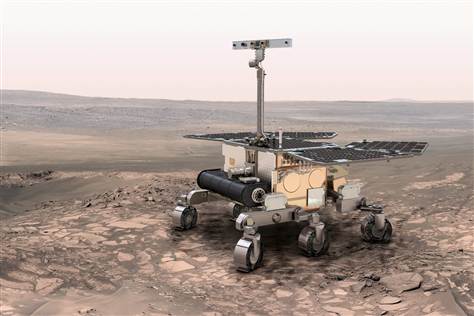1) a second rover based on the Curiosity platform
2) humans orbiting Mars in the 2030's - no boots on the ground.
Sorry, but to me 2) seems like getting just a light kiss at the door after the 3rd date
2) humans orbiting Mars in the 2030's - no boots on the ground.
Sorry, but to me 2) seems like getting just a light kiss at the door after the 3rd date

NASA will send second Mars rover in 2020, send humans in 2030s
The administration will play small roles in Europe-led missions in 2016, 2018.
NASA has announced plans for a second Mars rover to launch in 2020, while maintaining small roles with missions planned by the European space agency. If all goes as planned, NASA hopes to put astronauts in orbit around Mars by the 2030s, per the wishes of President Obama.
The current Mars budget is $581.7 million, but back in February was set to be cut by over $200 million, according to two scientists briefed on the matter who spoke to the Associated Press. According to the AP, the European Space Agency spoke to Russia about filling the US’s vacancy in the programs, which would map sources of methane on Mars and drill into the ground for evidence of life.
In a press event at a meeting of the American Geophysical Union, NASA associate administrator for science John Grunsfeld announced that the administration will in fact play roles in the two ESA missions. NASA will provide the UHF communications systems for the 2016 mission, and in 2018 will provide a molecular analyzer for the ExoMars rover. Grunsfeld noted that the Russian space agencies will constitute a “major partnership†in both ESA-led missions.
As for the NASA-led mission to launch in 2020, Grunsfeld noted that NASA will begin work on the rover imminently, with the same team that worked on the Curiosity rover wandering Mars right now. He noted that the spare rover parts designed for the Curiosity mission would become "prime for the 2020 mission."
Looking beyond the next decade, Grunsfeld stated support for President Barack Obama’s desire to send humans to Mars. In a press release related to Grunsfeld’s announcement, NASA stated that “the 2020 mission will constitute another step toward being responsive to high-priority science goals and the president's challenge of sending humans to Mars orbit in the 2030s.â€
Grunsfeld made note of budgetary concerns between allocations made by ESA versus those made by NASA, stating “these ExoMars missions are not in [ESA’s] science portfolio… at NASA we have different buckets representing the science piece.â€
Part of the budgetary problem is that current programs have run over budget, including the James Webb Telescope, which was originally budgeted at $3.5 billion but is now projected for $8 billion. The Mars science laboratory also ran over to $2.5 billion from its original projected cost of $1.5 billion. The press release notes that the 2020 mission fits within the five-year budget plan in Obama’s 2013 budget, and is “contingent on future appropriations.â€
NASA’s full budget for 2013 will be released on Monday.
The administration will play small roles in Europe-led missions in 2016, 2018.
NASA has announced plans for a second Mars rover to launch in 2020, while maintaining small roles with missions planned by the European space agency. If all goes as planned, NASA hopes to put astronauts in orbit around Mars by the 2030s, per the wishes of President Obama.
The current Mars budget is $581.7 million, but back in February was set to be cut by over $200 million, according to two scientists briefed on the matter who spoke to the Associated Press. According to the AP, the European Space Agency spoke to Russia about filling the US’s vacancy in the programs, which would map sources of methane on Mars and drill into the ground for evidence of life.
In a press event at a meeting of the American Geophysical Union, NASA associate administrator for science John Grunsfeld announced that the administration will in fact play roles in the two ESA missions. NASA will provide the UHF communications systems for the 2016 mission, and in 2018 will provide a molecular analyzer for the ExoMars rover. Grunsfeld noted that the Russian space agencies will constitute a “major partnership†in both ESA-led missions.
As for the NASA-led mission to launch in 2020, Grunsfeld noted that NASA will begin work on the rover imminently, with the same team that worked on the Curiosity rover wandering Mars right now. He noted that the spare rover parts designed for the Curiosity mission would become "prime for the 2020 mission."
Looking beyond the next decade, Grunsfeld stated support for President Barack Obama’s desire to send humans to Mars. In a press release related to Grunsfeld’s announcement, NASA stated that “the 2020 mission will constitute another step toward being responsive to high-priority science goals and the president's challenge of sending humans to Mars orbit in the 2030s.â€
Grunsfeld made note of budgetary concerns between allocations made by ESA versus those made by NASA, stating “these ExoMars missions are not in [ESA’s] science portfolio… at NASA we have different buckets representing the science piece.â€
Part of the budgetary problem is that current programs have run over budget, including the James Webb Telescope, which was originally budgeted at $3.5 billion but is now projected for $8 billion. The Mars science laboratory also ran over to $2.5 billion from its original projected cost of $1.5 billion. The press release notes that the 2020 mission fits within the five-year budget plan in Obama’s 2013 budget, and is “contingent on future appropriations.â€
NASA’s full budget for 2013 will be released on Monday.




 ), or one of those other moons that appear interesting?
), or one of those other moons that appear interesting?
Comment